
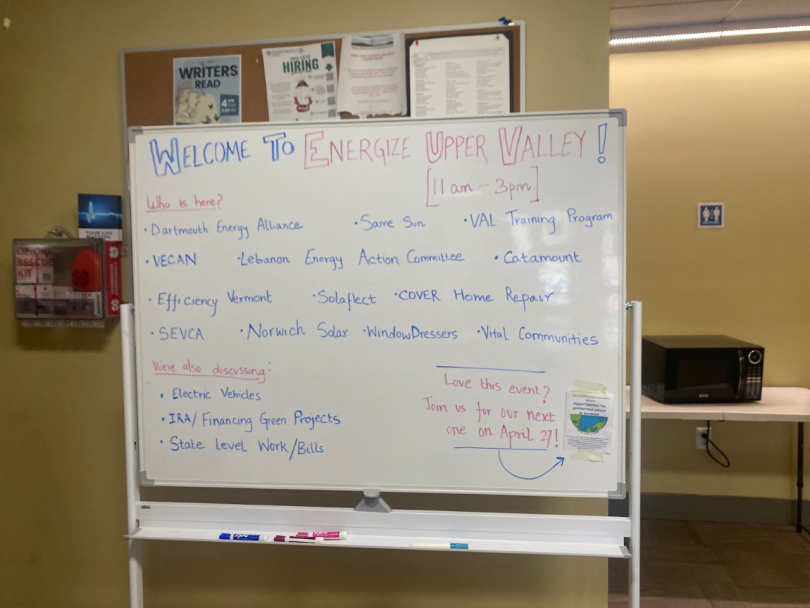
In April 2023, students from Dartmouth's Energy Justice (EJ) Clinic and the Dartmouth Energy Alliance went to LISTEN Community Dinner Hall in White River Junction, VT for the 'Energize the Upper Valley' Fair. EJ Clinic members Ali Bauer '25 and Camry Gach '26 share their takeaways in this report.

On April 1, 2023, students from Dartmouth's Energy Justice Clinic and the Dartmouth Energy Alliance went to LISTEN Community Dinner Hall in White River Junction, VT for an 'Energize the Upper Valley' Fair.
We went to the fair to answer a variety of questions. We were first wondering what brought others to the fair (i.e. Paying energy bills? Advocating for change? Learning about change? Representing an organization/energy group?). We also wanted to know what questions people in the Upper Valley have about the energy resources available to them. We were next interested in hearing what people in the Upper Valley already know about energy and how, based on this information, Dartmouth can be part of the effort to help homeowners in managing their energy expenses and help advance energy literacy. Finally, we wanted to get a sense of community outlook on Community Choice Aggregation.
In addition to our Dartmouth groups, representatives from the following groups were present: Same Sun, Lebanon Energy Action Committee, VECAN, Catamount, VAL Training Program, Efficiency Vermont, SolaFlect, COVER Home Repair, SEVCA, Norwich Solar, WindowDressers, and Vital Communities. The fair was broken down into three rounds—(1) electric Vehicles, (2) IRA/Financing Green Projects, and (3) State level work/bills.
Demographics at the fair were predominently white, middle-aged or older Upper Valley residents who were either already highly knowledgeable about energy—often affiliated with a group or running a table—or were homeowners/renters with a specific personal question about energy in the Upper Valley. Through talking with people at the fair, we learned a lot about energy access and transitions in the Upper Valley!
Understanding Community Choice Aggregation in New Hampshire
First-year Dartmouth student Camry Gach's goal in speaking to different representatives from different booths was to get a better sense for herself about the Community Choice Aggregation program in New Hampshire and the initiatives that organizations have in place to reduce energy insecurity issues in the area. She learned more about how the Community Choice Aggregation program in New Hampshire generally works and about the rebates offered to improve home energy efficiency in the Upper Valley. We will share her experiences interacting with these organizations and how these exchanges shaped her perspective on energy justice programs.
Gach first spoke to Dave, who represented a booth called Solaflect, a company that installs solar trackers, usually mounted onto the ground, which effectively increase the energy output of a standard PV panel by maintaining consistent solar exposure throughout the day. Gach admits that being an engineer at heart, she was intrigued by this technology and did indulge in getting a few of her own solar tracking questions answered.
However, one of her priorities in attending the fair for the Energy Justice Clinic was to understand the Community Choice Aggregation program better. Not knowing who to approach first, she decided to start somewhere and began asking Dave her questions. Fortunately, Dave was quite knowledgeable about the different utilities within the Upper Valley and the impacts of Community Choice Aggregation in New Hampshire's energy system. He laid out the reality of the built energy environment: the original connections built between a home and a utility's distribution and transmission systems are long lasting. It is costly and physically difficult for a homeowner to opt out and reconnect their home to another utility's electrical sources. Consequently, the homeowner remains tied to that utility and the per-kilowatt-hour rates that it has established.
The Community Choice Aggregation (CCA) program provides an intervention: the utility still facilitates the transmission and distribution of electricity for a participating homeowner, but this program gives people living in towns that pass Community Power Electric Aggregation Plans the choice of where to acquire their energy sources, often by participating in joint power solicitations. Dave explained how members of the program may provide additional funding to the program in order to expand the selection of renewable energy options available—and thus the flexibility in prices—in the CCA program. By accepting automatic enrollment through the program—which took effect this April—a homeowner will be supporting an initiative to expand the local grid's renewable energy sources and reduce local energy insecurity throughout the participating towns, which include Enfield, Exeter, Hanover, Harrisville, Lebanon, Nashua, Peterborough, Plainfield, Rye and Walpole.
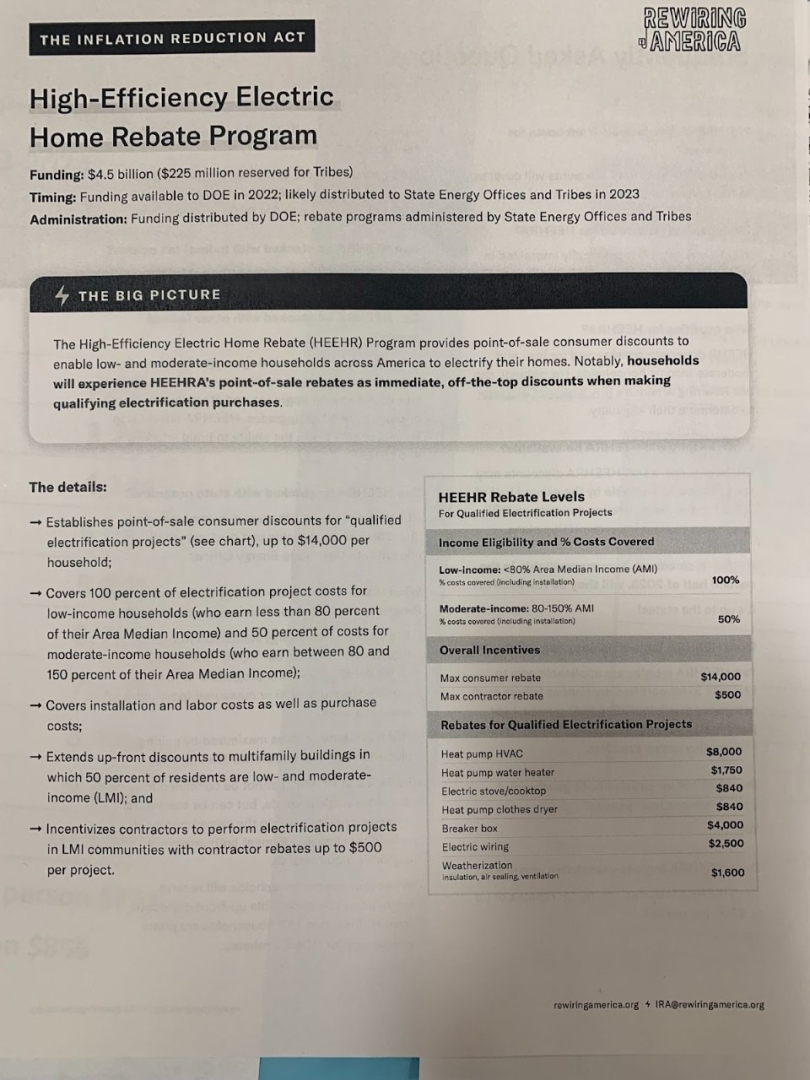
Funding Efficiency Rebates in Vermont
Next, she spoke to an energy consultant who works with the Vermont Energy Investment Corporation, the founding non-profit behind Efficiency Vermont's rebate program. He explained to her the funding process for efficiency rebates. Gach noted a key question going through her mind prior to her discussion with the VEIC representative: "Where does all this money for rebates come from?"
From her discussion with the representative, she learned that Vermont has pioneered an innovative utility structure involving the creation of a public efficiency utility, a government-funded agency with the mission to improve home energy conservation and reduce a homeowner's energy bills. Gach conceptualizes this structure as it relates it to the kinds of social-welfare initiatives that the government provides from U.S. tax dollars, serving as a kind of intervention between the laissez-faire capitalist normatives of profit-making and some of the more disadvantaged consumers themselves. It calls for a pause and looks at how to make the system more efficient for the individual user before warranting further economic expansion.
However, the representative also mentioned that the public utilities commission evaluates the effectiveness of this efficiency program every three years and adjusts its budget accordingly. To put it more blatantly, the success of Vermont's efficiency program is dependent on how much people use it. The more homeowners are aware and engaged in the resources provided to make home efficiency improvements, the more money the utilities commission can justify to incorporate into the efficiency program budget. The survival of a program like this is based on public awareness and education. That puts a great deal of responsibility on energy justice activists, efficiency organizations, and the homeowners themselves to expand the program, but it is also a prospect filled with immense opportunity and community power.
Going back to Gach's original question on where the money comes from, the Efficiency Vermont program demonstrates how the Vermont state government currently supplies these funds which are originally generated from the profits of state electrical utilities. In addition, a representative at the South East Vermont Community Action (SEVCA) booth, mentioned that some of the budget allocated through the Inflation Reduction Act also contributes to these kinds of efficiency initiatives and expands the funds currently available for homeowners who apply for efficiency rebates.
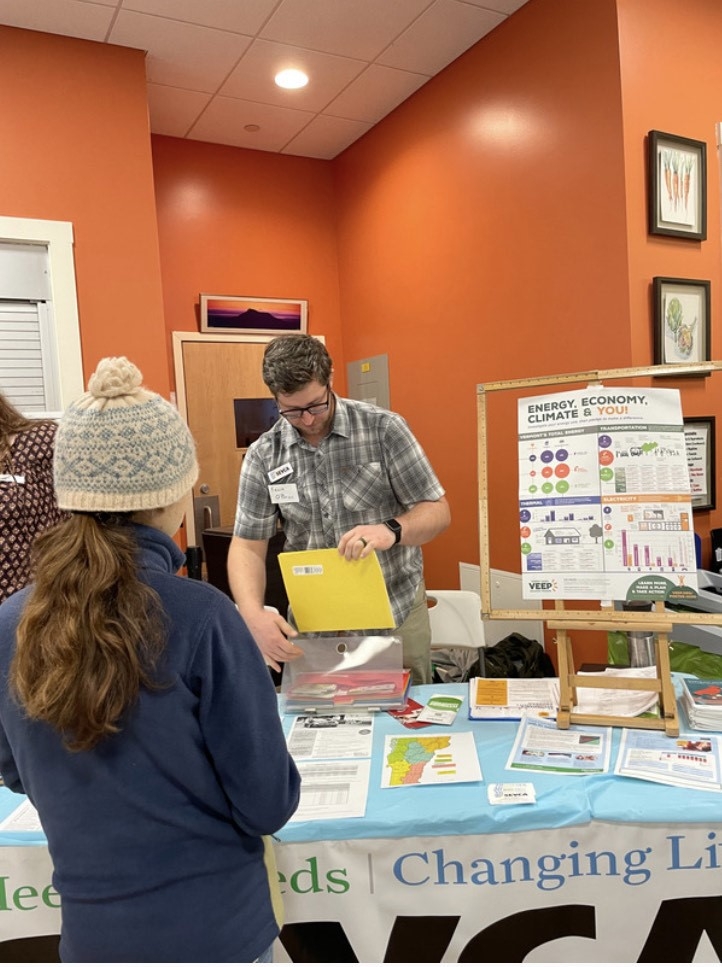
Gach found interesting differences between the utility structures in Vermont vs. New Hampshire. In Vermont, there is no CCA program, but by contrast, New Hampshire's energy efficiency programs do not provide as robust funding nor assistance as those of VT. Each state's set-up has its pros and cons. The CCA program in New Hampshire provides customers with an alternative energy rate choice, while the VT's efficiency programs provide greater access to efficiency rebates, which could amount to significant energy savings over the long term.
Dartmouth '25 Ali Bauer found Gach's observations very interesting, noting that the reality of energy is constantly evolving. Specifically, Bauer shares that a homeowner at the "Energize the Upper Valley" fair shared about how when she built her home decades ago, it was seen as super advanced and efficient, and now, the homeowner admits that her home is considered very old and relatively inefficient. Bauer wondered about current efforts to advance energy literacy in the Upper Valley and looked to local experts at the fair for answers.
Lynn Bohi from the Hartford Energy Commission explains that she has been working on advancing energy literacy since 2008. Bauer asked Bohi what she knows and wants to share about energy in the Upper Valley, and she says: "insulation is almost always first," suggesting that insulation is often the first aspect of a home looked at when assessing energy efficiency. Specifically, in looking into energy insecurity, an energy audit is often conducted, followed by necessary insulation, before other energy efficiency tactics are employed. Bauer and Bohi next discussed challenges to advancing energy literacy. Bohi says, "it's hard to have people go to you, so we try to go to them." She explains that she goes with the Hartford Energy Commission to Trunk or Treat, an annual social event around Halloween involving giving out candy and other goodies from the back of one's car. Bohi explains that she "tries to be present at public town events to give information and answer questions."
Bohi expressed exhaustion of talking about energy justice without seeing any major solutions, which prompted Dartmouth '25 Adamari Benavidez to reflect on discussions with Indigenous groups. Adamari voices that, in her understanding, Indigenous groups want to help and teach others of their culture and what they need, but they are tired of constantly having to say the same thing over and over to a shifting set of actors. To this, Adamari says, "that's why it's important to make good on our small promises." Adamari explains that in saying this, she is referring to something Professor Kelly has mentioned multiple times in our Energy Justice class, how important it is—with our positionality of participant observation researchers—to establish and maintain trust with the communities we work with. By starting with small collaborations and making good on our promises, we can help create the change they want to see without being a burden.
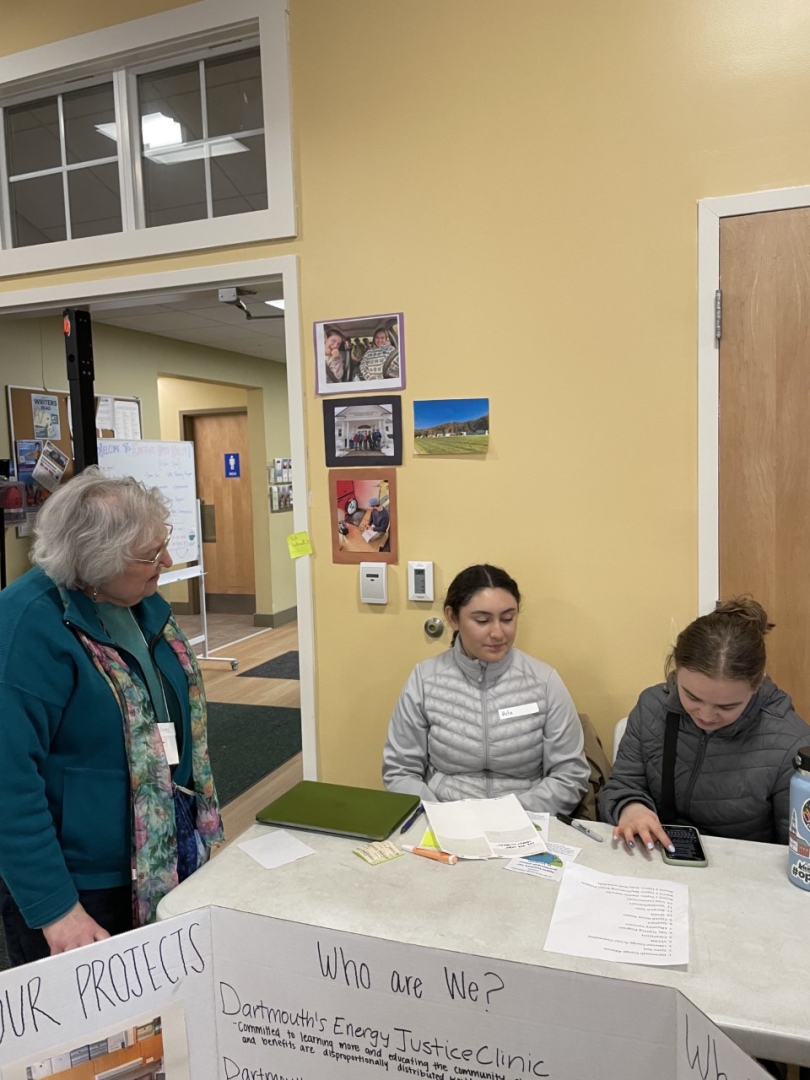
When Bauer finally asked Bohi if she had any remaining questions about energy, she pointed out that the energy fair failed to discuss and provide information about heat pumps — as a student researcher from the clinic, Bauer wonders why this is and if other community members were wondering this too. In addition to this missing piece of the fair that Lynn pointed out, Bauer noted other unanswered questions. Local energy expert Jesse wants to know how people in the Upper Valley get their news and information (newspaper, social media, ect.), a homeowner had questions about putting solar onto a 65 acre property and solar development in rural Hartford, and a renter and former homeowner was interested in learning more about dishwashers and rebates. Additionally, Bauer and Gach still wonder: although Dartmouth does not receive its energy through the CCA as a result of its commitments to a third party provider, has it provided any financial assistance in any way for the program's expansion? How are additional energy sources added onto the selection of CCA sources and who pays the initial costs to get these sources online and incorporated into a utility's grid?
We did some research to answer these questions and found that the energy sources used in the CCA program are not directly chosen by individual community members themselves but rather a non-profit Joint Powers Agency incorporated on October 1, 2021 — governed "by communities, for communities" called the Community Power Coalition of New Hampshire (CPCNH). This body contracts with outside electricity generators in order to provide a variety of energy rates for homeowners to choose from that vary in cost and carbon footprint. In essence, the CPCNH facilitates complex political and financial decisions for local towns to acquire greener power alternatives. Regarding Dartmouth's involvement in the transition to Community Power, a recently published article in "The Dartmouth" states: "Given that Dartmouth College procures electricity through a third-party supplier, it will not become automatically enrolled in Hanover Community Power." The article's authors, however, do mention the possibility for at least some of Dartmouth's power supplies to be procured through the CCA and are optimistic about the college's sustainability goals falling in line with the green-energy initiatives of the CCA.
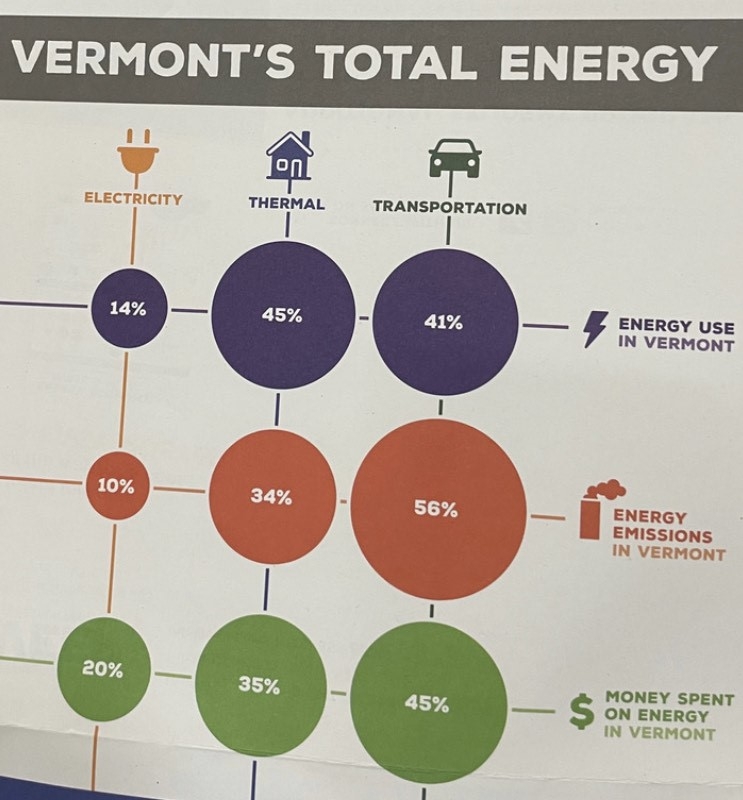
Moving forward, the Lebanon Energy Advisory Council is in the process of rewriting the Lebanon energy master plan, taking energy and environmental justice into account. Specifically, Woody Rothe, a representative from the Lebanon Energy Advisory Committee, has been championing the equity section of the new master plan, and he is looking for community organizers to go to low income houses in order to get the word out to these populations about financial opportunities to weatherize their homes. As expressed by Bohi, our current public policy still has a great deal of improvements to make in bridging the energy access gap. However, Rothe's efforts provide just one example of local efforts to promote a more just energy future.
Navigating between different energy rate structures and efficiency funding resources can become complex, but doing so is the first step for homeowners to save money, energy, and carbon emissions. An energy fair like the one we attended is an excellent way to help local communities understand their options. As individual consumers, we each have purchasing power that we can use to promote greater accountability for energy's impacts not only on climate change, but also on communities disproportionately affected by historically unjust energy access issues. At such a critical time in the renewable energy transition, it's time to learn how we can take advantage of these new efficiency and community power programs in order to make responsible individual decisions that will benefit the community and the planet for future generations to come.
The Dartmouth Energy Justice Clinic will be hosting an information session and Q&A panel to provide more resources for the campus and larger Hanover community to understand the Community Choice Aggregation program better. The presentation will take place in Fairchild 101 on Thursday, May 18, 2023 at 4:30pm. We hope to see you there!
https://www.cpcnh.org/
https://www.communitypowernh.gov/
https://sustainablehanovernh.org/